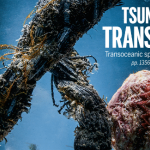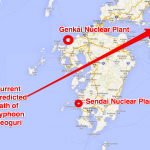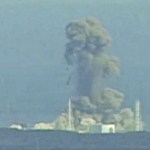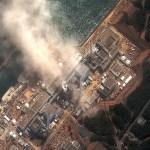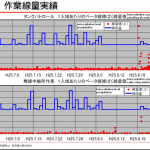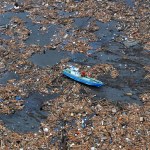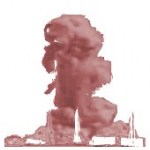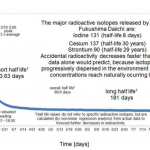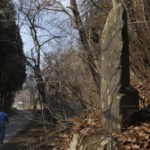Japan Disaster
When the big tsunami hit Japan in 2011, many objects were washed out to sea. This flotsam provided for a giant "rafting event." A rafting event is when animals, plants, etc. float across an otherwise uncrossable body of water and end up alive on the other side. With this particular event, I don't think very many terrestrial life forms crossed the Pacific, but a lot of littoral -- shore dwelling and near shore -- animals and plants did.
Even though the Pacific ocean is one big puddle and you would think that any organism anywhere in it could just go to any other part of the ocean, like in the…
Great disasters are great stories, great moments in time, great tests of technology, humanity, society, government, and luck. Fifty years ago it was probably true to say that our understanding of great disasters was thin, not well developed because of the relative infrequency of the events, and not very useful, not knowledge that we could use to reduce the risks from such events.
This is no longer true. The last several decades has seen climate science add more climatic data because of decades of careful instrumental data collection happening, but also, earlier decades have been added to…
Three years after the disaster at Fukushima, science correspondent Miles O'Brien returned to the Daiichi nuclear plant for an exclusive look at the site. Follow Miles on a never-before-seen tour of Daiichi's sister site, Fukushima Daini, which narrowly avoided a meltdown during the Tohoku earthquake. As the country debates turning its reactors back on, Miles asks: will Japan have a nuclear future?
Update:
The new forecast track of Neoguri is shown above as well as the location of two nuclear power plants.
The forecast track has moved south, and is now in a very good (and here good means bad) position to strike the Sendai nuclear power plant very directly. Keep in mind that this forecast may change.
On Tuesday mid day UTC the storm will likely be in the later phases of a turn to the right, aiming roughly at the Sendai plant. At this point maximum wind speed near the center of the storm will likely be about 90 mph, which puts the storm in the middle of the Category One range. That…
On March 11th, 2011, a large earthquake caused a large tsunami in Japan, and the two historic events wrecked the Fukushima Daiichi nuclear power plant. The power plant had six boiling water reactors of the kind used around the world in many nuclear power plants. Three of the six reactors suffered a meltdown, and containment structures meant to contain a meltdown were also breached. This is regarded as one of the worst nuclear disasters to ever happen, possibly the worst of all, though comparing major nuclear disasters to each other is hard for a number of reasons.
As you know if you are a…
TEPCO is removing some of those famous spent fuel rod assemblies, here's some video:
TEPCO was going to start removing the fuel rods from the less-damaged reactor building Numnber 4 over the next few days. Today, it was announced that damage to the fuel rod assemblies, some or most of which predated the tsunami and earthquake, this could not be done. There is now uncertainty as to what is going to happen.
Here is a video by Fairewinds about this operation, which I believe was made before TEPCO decided to not continue with the removal at this time:
As you can see, there are several possible problems. Most of these problems are not related to the reasons TEPCO has given to…
Fukushima Update #70: If you can't measure it, you can't analyze it.
by Analiese Miller and Greg Laden
It has been suggested, by various commenters on the internet, that the problem with Fukushima is not that there is a dangerous radioactive mess there, but rather, that the authorities in charge have decided that exposure to radiation is dangerous, when it really isn’t. The argument has been made that the evacuation of the region around Fukushima at the time of the meltdowns and explosions was unnecessary. This presumably also means that the exclusion zones, where people are not allowed to…
News from Fukushima Update # 69
by Ana Miller and Greg Laden
Over the last several weeks we’ve heard repeated, alarming, and generally worsening, news from Fukushima Diachi, the Japanese nuclear power plant that suffered a series of disasters that make The China Syndrome look like a Disney family movie. One question is this: Has a new set of problems (new leaks, apparently the fifth such “unexpected” leak) occurred that is really significant, or is this level of spewing of radioactive waste from the plant pretty much run of the mill but somehow the press only now noticed something TEPCO has…
Patrick J. Kiger at National Geographic News has an excellent summary of the current situation at Fukushima Daiichi Nuclear Power Plant. The plant continues to leak radioactive material into the sea, though at a rate much lower than the massive release that happened at the time of the accident. Strontium-90 (Half-life 28.79 years) has increased in proportion over various Cesium isotopes. This is a concern because while Cesium has the potential to enter the food supply in fish that pick it up, Strontium enters the food supply in a different way. In theory Cesium enters tissues and leaves…
On March 11th, 2011, the Fukushima Daiichi nuclear power plant complex suffered damage from an earthquake and ensuing tsunami that caused multiple nuclear reactor core meltdowns and melt-throughs, explosions, and major releases of radioactive material into the air and the sea. In addition to the reactor meltdowns and melt-throughs spent fuel storage tanks were also damaged and probably contributed to the release. It took about a year for the plant to reach a condition that was stable enough that we stopped checking it every day to see if new bad things were happening. Heroic efforts were…
Almost exactly one year ago, a very large double strength tsunami struck the Pacific Coast of Japan and washed a huge amount of stuff out into the sea. The oceanic born debris of terrestrial origin looked in places like this:
source
Subsequently attempts were made to model the movement of the debris in the Pacific. Some of the debris would likely end up on the coast of the US, so some of the models asked that question: When can Tsunami Salad start to wash up on the beaches of California, Oregon and Washington? I'm sure that everyone who's thought about this for even a few seconds realizes…
Because the situation is alarming.
There is still a great deal of uncertainty about where the melted-down fuel at Fukushima I's reactors is resting. TEPCO and various NPA's have insisted all along that they know where it is, and everything is under control. The most recent information from TEPCO is that the fuel is contained in the containment vessel, but they won't be able to confirm that for ten years when it cools down enough to go have a look. Recent efforts to peek inside the rubble have been hampered. One attempt resulted in very blurry photographs ... apparently the high levels of…
In the beginning of the Fukushima Nuclear Crisis, in the hours and days after the earthquake and tsunami struck, nuclear power experts assured us that no matter how bad it seemed, nuclear material would stay in the reactors. It was unlikely that the reactors would melt down, and if they did melt down a little, that would be OK because the melted down stuff would stay within the reactor vessels. No problem. What actually happened, however, is that the nuclear material in three of the reactors totally melted down, and then melted through in perhaps two or three of the reactors, but at least…
There is a lot of news in Ana's Feed about the nuclear power industry world wide, as well as across Japan, and especially disturbing news related to the Fukushima plant in particular. In brief, the main reason that the situation at these reactors seems to be kinda-sorta under control (as in the water in the plants has stopped boiling uncontrollably) is that much of the nuclear fuel has melted its way into the underlying geology, and/or all over the plant's foundation structures, and/or dispersed through groundwater that is moving through the system. Towards nearby rivers and/or the ocean…
The Fukushima nuclear power plant was opened to journalists for the first time; See below for numerous links to related stories.
There appears to be very high levels of radiation at Fukushima plant reactor #3, and at either reactors 1 and 3, or both, nuclear fission may have been occurring in the melted down remains. Ideally, once a plant is turned off, i.e., control rods inserted etc. etc., the state of "criticality" is stopped and there is no more fission, or at least, only a small background level. But, if a nuclear power plant's core melts down, nuclear material can re-accumulate in…
The radiation at the Fukushima plants has gone up, rather than down, since June. This may be because contaminated water has become more concentrated due to evaporation. The release of radiation from the plant into the air continues, although a covering over Reactor 1 is almost completed. The release of radiation from the plant into the sea continues, and plankton are shown to be contaminated to a level that raises some concern. Mid month, the plant was measured to be releasing about 100 million becquerels per hour. The reactors are still not uniformly shut down to less than boiling.…
The latest update on the crisis in Fukushima. The hot spots are everywhere. Be careful where you step!
But first, we'd like to introduce the handy-dandy Fukushima Post and Ana's Feed search engine. This search engine will return results from this series of posts we've done. This is a good place to start if you are researching anything about fukushima:
Loading
google.load('search', '1', {language : 'en'});
google.setOnLoadCallback(function() {
var customSearchControl = new google.search.CustomSearchControl('003496823222673328486:9ldvf83rzsa');
customSearchControl.…
As a result of our last posting on Fukushima, we had a discussion initiated by commenter Daedelus2u about radioactive istopes of Cesium becoming concentrated in fish. I thought I'd take this opportunity to expand on that discussion a little. This relates to the possibility that radioactive elements spilled or spewed from a nuclear reactor site (as per normal or following a meltdown and China Syndrome, as in the case of Fukushima) can become part of our diet especially in fish, and how much concentration of radioactive isotopes we might expect.
Ana's feed is loaded with startling and…
